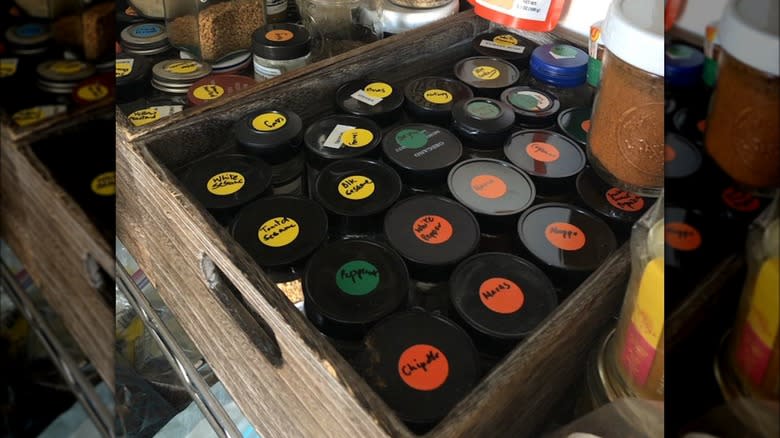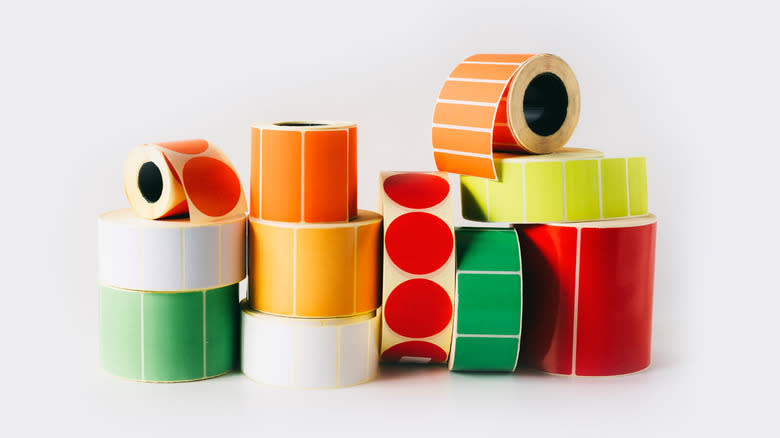A Color-Coded Pantry Is The Secret To An Organized Kitchen

Struggling to keep your kitchen tidy? If so, you're not alone. The kitchen is the activity hub of a household. It's where family members cook meals, do homework, work on art projects, and gather to chat. Chances are, when you get home, you head straight for the kitchen and prepare yourself a snack. The kitchen is so well-used, it's no wonder it gets messy. People are always coming in and out, and after they use items, they don't always put them back. Luckily, we have a secret weapon to combat this issue: a color-coded pantry.
Pantries are at the core of kitchen organization. It's where people store dry goods, beverages, cooking utensils, cleaning products, and more. There's a lot going on, and if it's not obvious where things belong, things can devolve into complete disarray. Color-coding your pantry can simplify organization by creating shortcuts in the brain. It'll be easy to find what you're looking for and return it to its place. Plus, you won't have to explain where things are to family and friends because, in a well color-coded system, it'll be obvious.
Although color coding your pantry takes some work, it'll save you time and energy in the long run. And considering how much time you spend in this part of the house, it's worth taking the steps to organize your pantry. So if you're ready to start, read on for tips and tricks to color-code your pantry.
Read more: The Best Way To Clean That Nasty Grease Off Of Your Kitchen Cabinets
How To Color-Code Your Pantry

The key to color-coding your pantry is creating a system that makes sense to you. Separate things into groups that naturally go together (like products would be organized in a grocery store). Think condiments, produce, cooking utensils, and cleaning supplies. Nuts and dried fruits can all go in one section, and ready-to-eat snacks like chips in another. Groups with many small items can be put in larger containers.
Now, there are two ways to color-code the different sections of your pantry. You can allocate a single color for each section, choosing a color closely associated with the item. For example, veggies could go in a green section while cleaning supplies could go in a blue one. Or you could organize each section according to the rainbow. For canned goods, red products like salsas would go on one end, followed by yellow corn, green peas, and so on. With produce, you could have baskets according to color. Red tomatoes in one, followed by oranges, lemons, limes -- you get the idea.
Another important aspect of organizing your pantry is product placement. It might make sense for cleaning products to be close to the ground while cookbooks can be up high. Meanwhile, items you use frequently should be more accessible. Keep smaller items like spices at eye level so you don't have to rummage around to read each label -- or better yet, write the name of each spice on a color-coded sticker.
Tools To Help You Color-Code Your Pantry

Deciding how to separate your pantry products is the first step. But you need the actual colors and tools to bring it to life! This is where you can get as creative as you'd like -- or keep it super simple.
If you're a fan of label-making, don't hold back. Bust out the colored markers and have your kids pitch in with DIY labels, or go all-out using a fancy label-maker. It can also be handy to create a color-coded key for your pantry. Hang it somewhere obvious so anyone who visits will easily notice it and use it accordingly.
Beyond labels, it helps to have the appropriate storage containers. There are several types of pantry containers to stay organized. Glass jars are great for decanted items and have an aesthetic appeal. Meanwhile, baskets and canisters are excellent for items you'd like to display openly, and sealed bins are good for linens and cleaning products. Don't forget to add the color-coded labels, or a strip of colored tape, to each one. This way, when the container runs empty, you'll know exactly what you need to replace.
Read the original article on The Daily Meal.

